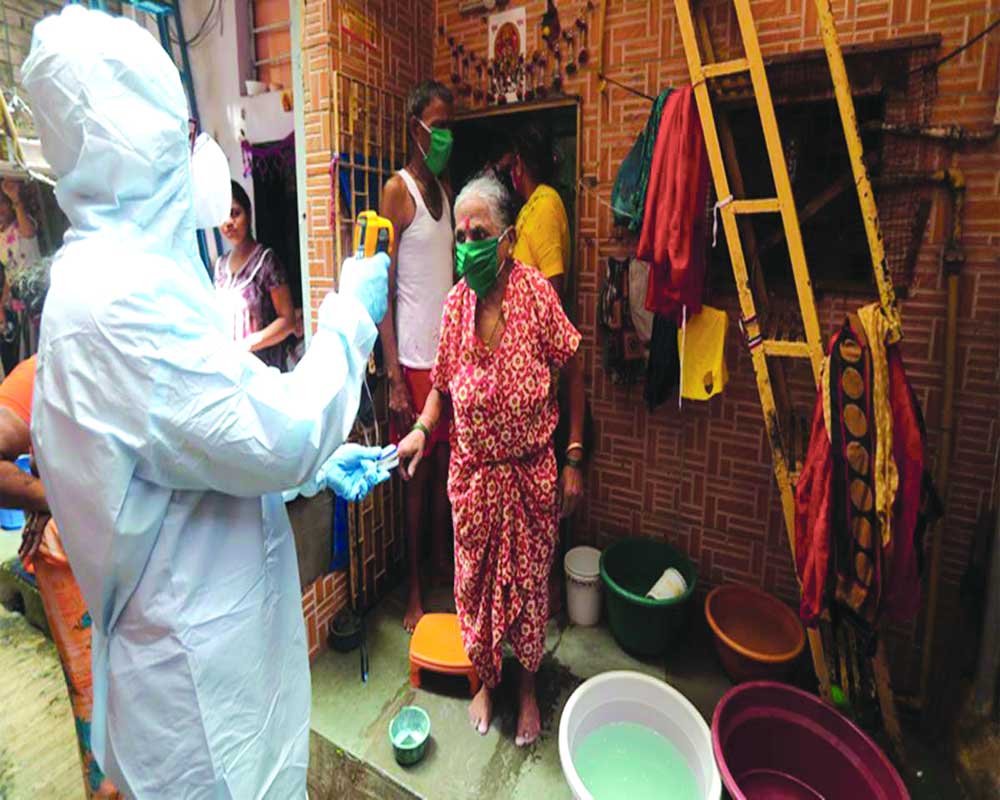WHO has praised Asia’s biggest slum for containing COVID-19 through community engagement and fast protocols
From being a major cause for concern to being praised by the World Health Organisation (WHO) for successfully containing the community spread of the Coronavirus, Asia’s largest slum Dharavi, with a population density of 2.27 lakh per sq km, has come a long way. Along with Italy, Spain and South Korea, Mumbai’s slum cluster has shown that even if the outbreak is very intense and happens in an under-serviced and infrastructure-scarce settlement, it can still be brought back under control. All it needs is a synchronised human drill. Dharavi is indeed a test case of how resource-deprived zones can fight the virus, too. Its 6.5 lakh residents live in an area of just 2.5 km, which challenges the golden mantras for fighting the pandemic, namely social distancing, frequent hand-washing and living in well-ventilated spaces. A minimum of seven to eight people live together in small, 100 square feet dwellings and queue up for water each day as piped water at home is a luxury they can only dream of. A whopping 80 per cent of the slum-dwellers are forced to use community toilets and fresh air and good ventilation is a rarity as homes and factories co-exist in single buildings lining the slum’s narrow lanes. Yet, on July 7, the slum reported only one Coronavirus case and till July 10, the number of cases was just 2,359, a far cry from what was expected when the first case was discovered in Dharavi on April 1. In fact, Western Press editorials had written off Dharavi as a time bomb waiting to explode.
So what was it that the Brihanmumbai Municipal Corporation (BMC) did to turn the tide of the pandemic? Because even as the rest of Mumbai suffered and became a hotspot, Dharavi defied all logic and did not turn into a Corona cesspool. The BMC decided to take the problem by its horns and involved the community in its chase of the virus. It set up teams to reach out to families and they reached out to almost seven lakh people in Dharavi, tracking signs and symptoms and tracing contacts of the infected. Between April 1 and July 10, a whopping 47,500 households were scanned by doctors and private clinics. More than 3.6 lakh people were screened, out of which 14,970 people were screened in mobile vans, thus supplementing the work of overworked health centres. As many as 8,246 senior citizens were surveyed and as the key to containing any pandemic is rigorous testing, the BMC also ran fever clinics to let people get themselves checked without fear. They also checked people’s oxygen saturation levels and if they were below 95 per cent, they were taken to quarantine centres. The logic was that this was faster than testing and in any case it was not possible to test everyone. As it is, they were only able to test 13,500 people. The BMC also employed 350 local private practitioners and if someone was found to have symptoms, they could volunteer to be quarantined even without getting tested. Since home quarantine was never an option in Dharavi, local clubs and schools were converted into quarantine facilities where free food and health check-ups were provided. As many as 2,000 elderly were taken to protective quarantine and only critically-ill patients were admitted to hospitals while 90 per cent patients were treated inside the slum. All private hospitals were taken onboard and acquired for treatment, including Sai Hospital, Prabhat Nursing Home and Family Care. A 200-bed hospital was also set up in a record 14 days. What Dharavi did was that it focussed on community engagement. Politicians and NGOs provided thousands of free meals and rations while Bollywood actors and businessmen donated gear, oxygen cylinders, gloves, masks, medicines and ventilators. Dharavi also followed the basic rules of testing, tracing, isolating and treating all those who were sick and hence, broke the chain of transmission and suppressed the virus. And to make sure that the lockdown worked, free meals and rations were provided to residents trapped at home without work and a source of income. It’s not surprising then that Dharavi has turned out to be a beacon of hope for densely populated cities in poor nations and Delhi and other cities struggling with the pandemic could well learn a lesson or two from it. Human endeavour is the biggest cure.
(Courtesy: The Pioneer)








 OpinionExpress.In
OpinionExpress.In















Comments (0)